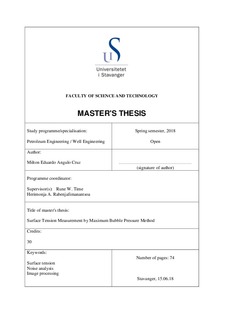| dc.contributor.advisor | Time, Rune | |
| dc.contributor.advisor | Rabenjafimanantsoa, Herimonja A. | |
| dc.contributor.author | Angulo Cruz, Milton Eduardo | |
| dc.date.accessioned | 2018-10-30T14:45:38Z | |
| dc.date.available | 2018-10-30T14:45:38Z | |
| dc.date.issued | 2018-06-15 | |
| dc.identifier.uri | http://hdl.handle.net/11250/2570227 | |
| dc.description | Master's thesis in Petroleum Engineering | nb_NO |
| dc.description.abstract | The principal objective of the present work is to measure the surface tension of liquids by the use of a method that it is not commonly found in books but it is based on very basic principles of Fluid Mechanics. This thesis is purely experimental. The measurement of the surface tension by The Maximum Bubble Pressure Method can be implemented with basic laboratory equipment on its simplest configuration but if a detailed analysis is desired can also be implemented with more advanced equipment to see what is involved inside the experiment, this also implies a higher level of complexity on data processing and understanding of the results.
In order to test the method, it was decided to use fluids that can be easily found in the laboratory and within the largest possible range of values of surface tension. These fluids are pure water, solutions of ethanol with a concentration of 10% and 30% in weight, n-Octane and n-Hexane.
The principle of the method is to inject air through a capillary tube with known radius that is submerged in a fluid at different depths, the maximum value of the injection pressure is recorded and the surface tension can be calculated. Based on this, some layouts were tested not only to measure these values but also to see how the bubble is formed over time with a slow-motion camera and how the pressure and temperature behave along the time with sensors attached to a computer. Several configurations and equipment were tested until obtaining the final distribution that meets the requirements.
Once the data was acquired, it was necessary to analyze the quality of it. Since the pressure and temperature signals were recorded by computer, some noise associated with the data acquisition was observed. For this reason, filtering techniques such as Low Pass Filter, Moving Average Filter and Fast Fourier Transform were implemented in a successful attempt to improve the reliability of the data. From the images captured by the slow motion camera it is possible not only to measure the dimensions of the bubble but to see how the interface between air and liquid behaves along the time.
The results obtained are shown at the end, it can be observed that the associated error to the calculations is no larger than 5.73%. Finally, the possible reasons of these errors are briefly discussed. | nb_NO |
| dc.language.iso | eng | nb_NO |
| dc.publisher | University of Stavanger, Norway | nb_NO |
| dc.relation.ispartofseries | Masteroppgave/UIS-TN-IEP/2018; | |
| dc.subject | petroleumsteknologi | nb_NO |
| dc.subject | petroleum engineering | nb_NO |
| dc.subject | surface tension | nb_NO |
| dc.subject | noise analysis | nb_NO |
| dc.subject | image processing | nb_NO |
| dc.title | Surface Tension Measurement by Maximum Bubble Pressure Method | nb_NO |
| dc.type | Master thesis | nb_NO |
| dc.subject.nsi | VDP::Teknologi: 500::Berg‑ og petroleumsfag: 510::Petroleumsteknologi: 512 | nb_NO |
